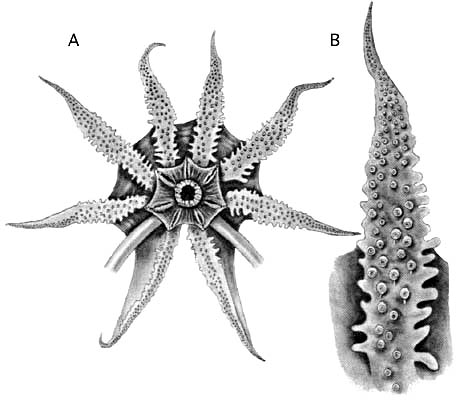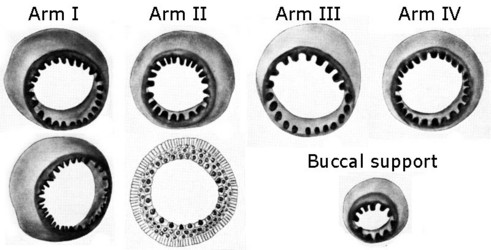Bathyteuthis bacidifera
Clyde F. E. RoperIntroduction
Bathyteuthis bacidifera was described from a few specimens taken in the Eastern Pacific Equatorial Water Mass, about 8° north and south of the Equator off northern Peru and southern Equador. It is distinguished from its sympatric congener, B. abyssicola, by the reduction of protective membranes on the arms and the retention of the trabeculae as free, finger like projections.
Characteristics
- Arms
- Protective membranes reduced or absent; trabeculae free, fleshy, elongate, finger-like.
- Arms short; tips blunt, not attenuate.
- Arm suckers numerous, about 150 on each of arms I-III.
- Arm sucker rings with 18-34 very closely packed, short, rounded to truncate teeth in the distal half grading to small, very closely packed (or touching) knobs in the proximal half.
 Click on an image to view larger version & data in a new window
Click on an image to view larger version & data in a new window
Figure. Oral views of the arms of B. bacidifera. Note the large, broad and somewhat irregular trabeculae in the proximal portion of all arms. Drawings from Roper (1968).
- Tentacles
- Tentacles and clubs relatively long.
- Head
- Beaks: Descriptions can be found here: Lower beak; upper beak.
- Gills
- Gills long, broad.
Nomenclature
The nomenclatural history of Bathyteuthis bacidifera Roper, 1968 is uncomplicated, as this species is so easily recognized, it occurs in a region where the deep-sea fauna is not frequently sampled, and its family was monographed shortly after the species was described (Roper, 1969).
Life History
The smallest paralarva observed, 6 mm ML, has the diagnostic feature of reduced protective membranes with free, finger-like trabeculae on the proximal 1/2 to 2/3 of the arms.
Distribution
The type locality is in the eastern South Pacific Ocean off northern Peru.
B. bacidifera occurs in depths of 600-1550 m in the highly productive waters of the Eastern Pacific Equatorial Water Mass and the Indian Ocean Equatorial Water Mass. The significantly larger gills with more lamellae in this species compared to other bathyteuthids, correlates with its distribution which is associated with oxygen minimum layers in the eastern tropical Pacific and equatorial Indian Oceans (Roper, 1969).
References
Roper, C.F.E. 1968. Preliminary descriptions of two new species of the bathypelagic squid Bathyteuthis (Cephalopoda: Oegopsida). Proceedings of the Biological Society of Washington, 81:261-272.
Roper, C.F.E. 1969. Systematics and zoogeography of the worldwide bathypelagic squid Bathyteuthis (Cephalopoda: Oegopsida). Bulletin of the United States National Museum, 291:1-210.
Verrill, A.E. 1885. Third catalog of Mollusca recently added to the fauna of the New England coast and the adjacent parts of the Atlantic, consisting mostly of deep-sea species with notes on others previously recorded. Transactions of the Connecticut Academy, 6(2): 395-452.
About This Page

Smithsonian Institution, Washington, D. C., USA
Page copyright © 2016
All Rights Reserved.
- Content changed 27 February 2016
Citing this page:
Roper, Clyde F. E. 2016. Bathyteuthis bacidifera . Version 27 February 2016 (under construction). http://tolweb.org/Bathyteuthis_bacidifera/19433/2016.02.27 in The Tree of Life Web Project, http://tolweb.org/










 Go to quick links
Go to quick search
Go to navigation for this section of the ToL site
Go to detailed links for the ToL site
Go to quick links
Go to quick search
Go to navigation for this section of the ToL site
Go to detailed links for the ToL site